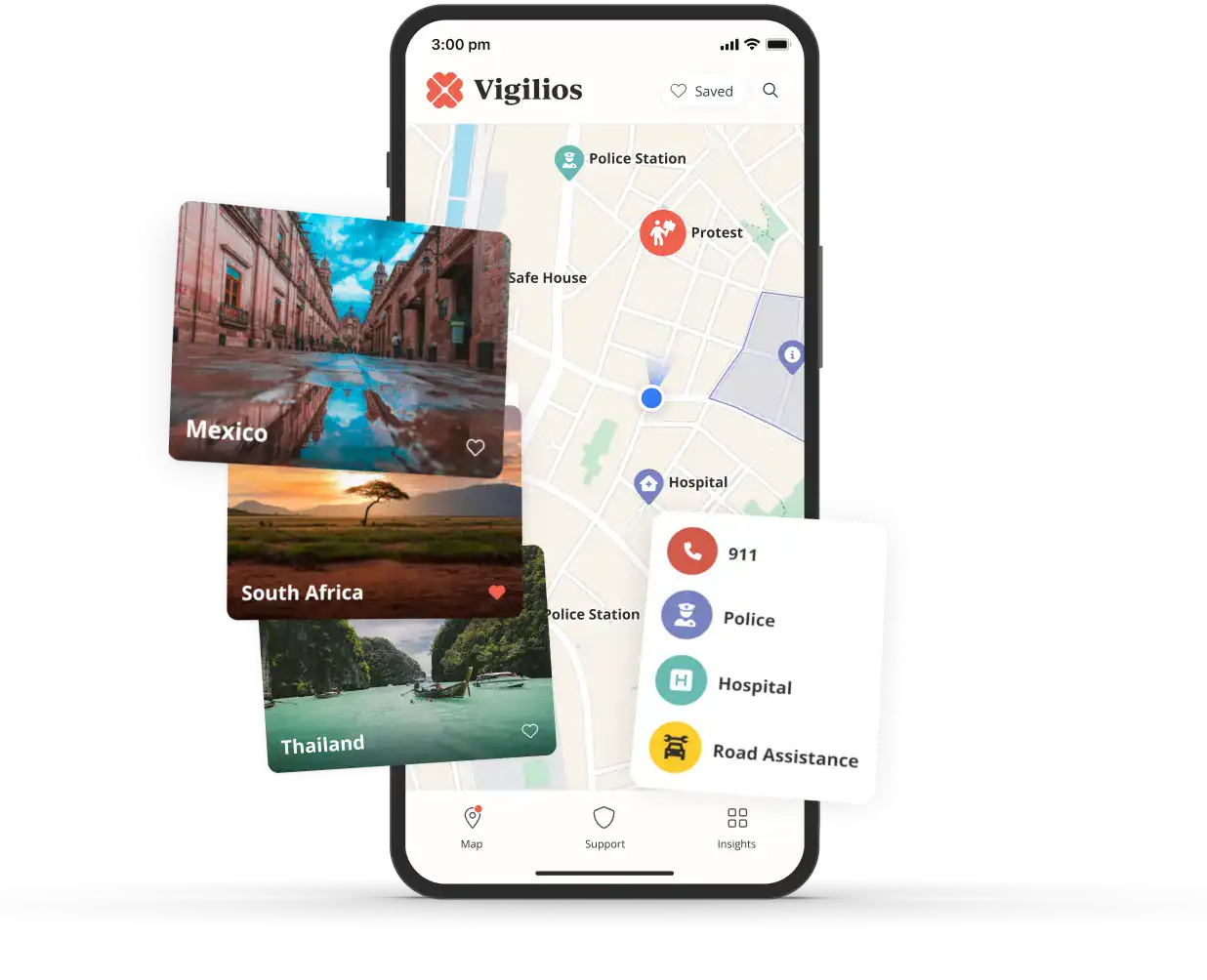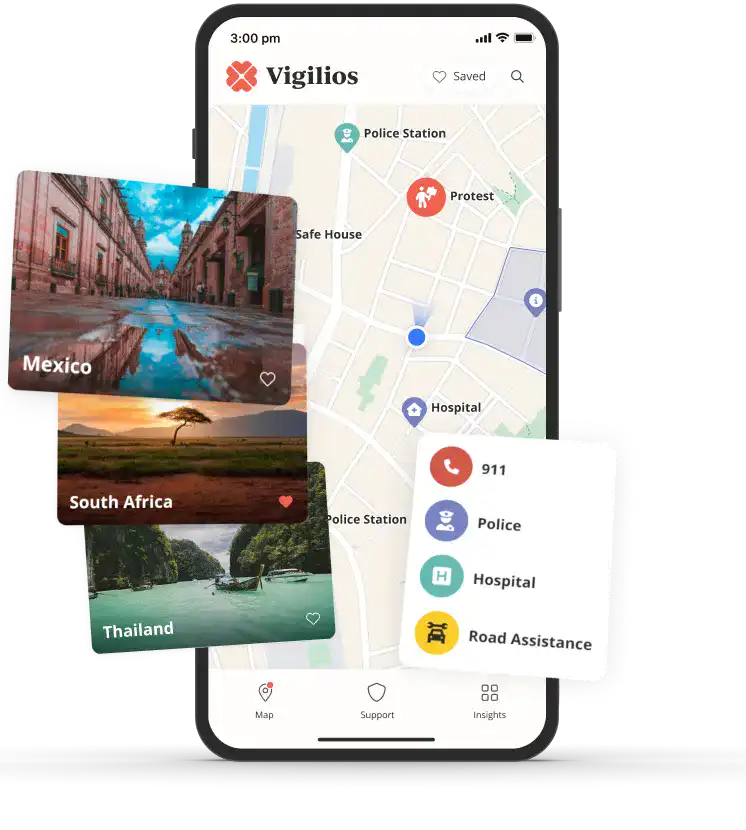


Is San Pancho Safe?
San Pancho is generally safe for travelers, with petty crime being the primary concern. Remain vigilant in crowded areas and at night. Insect-borne diseases like Zika and Dengue are risks, so use repellent. The tropical climate brings heavy rains and potential flooding during hurricane season. Respecting local customs and dressing modestly, especially in religious sites, is advised to avoid cultural insensitivity.
Safety & Security
San Pancho, a small coastal town in Mexico's Nayarit state, is generally considered safe for travelers. However, it's essential to exercise caution and be aware of potential risks.
-
Petty Crime: While violent crime is relatively low, petty crimes like pickpocketing and bag snatching can occur, especially in crowded areas or at night. Remain vigilant and keep valuables secure.
-
Scams: Be wary of common scams targeting tourists, such as overcharging for goods or services, fake tour guides, or taxi scams. Research reputable vendors and negotiate prices beforehand.
-
Civil Unrest: Although rare, protests or demonstrations can occur in Mexico. Monitor local news and avoid areas with civil unrest.
-
Drug-related Violence: While San Pancho itself is relatively peaceful, drug-related violence can occur in certain regions of Mexico. Avoid involvement with illegal activities and exercise caution, especially at night.
-
Natural Disasters: San Pancho is located in an earthquake-prone region. Familiarize yourself with emergency procedures and follow local authorities' instructions during natural disasters.
To enhance safety, consider staying in well-established accommodations, avoid isolated areas at night, and be cautious when interacting with strangers. Additionally, register with your embassy or consulate upon arrival and monitor travel advisories for any updates.
Health & Medical
San Pancho, a charming beach town in Mexico's Riviera Nayarit, offers a relatively safe and healthy environment for travelers. However, it's essential to take some precautions to ensure a smooth and enjoyable trip.
-
Vaccinations: Ensure you're up-to-date with routine vaccinations, including those for hepatitis A, hepatitis B, and typhoid fever. Consult your healthcare provider for specific recommendations based on your travel plans.
-
Insect-Borne Diseases: While the risk is generally low, mosquito-borne illnesses like Zika, dengue, and chikungunya are present in Mexico. Use insect repellent, wear long sleeves and pants, and consider staying in air-conditioned accommodations.
-
Water and Food Safety: Drink bottled or purified water and avoid consuming raw or undercooked food, especially from street vendors. Stick to well-cooked meals and fruits you can peel yourself.
-
Sun Exposure: San Pancho's tropical climate and proximity to the beach make sun protection essential. Use sunscreen, wear a hat, and seek shade during peak sun hours.
-
Medical Facilities: While San Pancho has a few small clinics, major medical facilities are located in nearby cities like Puerto Vallarta or Tepic. Ensure you have comprehensive travel insurance and access to emergency medical services if needed.
By taking these precautions and staying vigilant, travelers can minimize health risks and fully enjoy the beauty and charm of San Pancho.
Natural Disasters
San Pancho, located on Mexico's Pacific coast, experiences a tropical climate with distinct wet and dry seasons. While the region is generally safe from major natural disasters, travelers should be aware of the following potential risks:
-
Hurricanes: The hurricane season runs from June to November, with the peak months being August and September. San Pancho's coastal location makes it susceptible to the effects of tropical storms and hurricanes, which can bring heavy rainfall, strong winds, and potential flooding.
-
Earthquakes: Mexico is situated along the Pacific Ring of Fire, an area prone to seismic activity. While major earthquakes are infrequent in San Pancho, tremors can occur, and travelers should familiarize themselves with safety procedures.
-
Flooding: During the wet season, heavy rainfall can lead to localized flooding, particularly in low-lying areas or near rivers and streams. Travelers should exercise caution and avoid areas prone to flooding.
-
Rip Currents: The beaches in San Pancho can experience strong rip currents, which can be dangerous for swimmers. Beachgoers should heed warning signs and follow the advice of local lifeguards.
To mitigate risks, travelers should monitor weather forecasts, follow local authorities' instructions, and consider purchasing travel insurance that covers natural disasters. Additionally, it's advisable to familiarize oneself with emergency procedures and evacuation routes in case of an unforeseen event.
Transportation
San Pancho is a small, laid-back beach town with limited transportation options. While it's possible to get around on foot or by bicycle within the town, exploring the surrounding areas requires other means of transportation.
-
Taxis: Taxis are readily available and a common mode of transportation for visitors. However, it's advisable to agree on the fare before starting the journey to avoid potential overcharging.
-
Rental Cars: Renting a car provides flexibility and independence for exploring nearby attractions and towns. However, exercise caution when driving, as roads can be narrow and winding, and some areas may have poor signage or lighting.
-
Public Transportation: Local buses connect San Pancho to nearby towns like Sayulita and Puerto Vallarta, but services can be infrequent and schedules may vary. Ensure you have the latest information on routes and timings.
-
Road Safety: While the roads within San Pancho are generally safe for pedestrians and cyclists, exercise caution when venturing out of town, as some rural roads may be in poor condition or lack proper lighting and signage.
-
Ride-Sharing Services: Popular ride-sharing services like Uber operate in the area, providing a convenient and often safer alternative to traditional taxis, especially for solo travelers or at night.
Cultural Norms
San Pancho is a small, charming town in Mexico's Riviera Nayarit region, known for its laid-back atmosphere and rich cultural heritage. To fully immerse yourself in the local culture and ensure a respectful experience, consider the following:
-
Festivals and Celebrations: San Pancho hosts several vibrant festivals throughout the year, such as the annual Día de los Muertos (Day of the Dead) celebrations in November. Participating in these events can provide a unique insight into the town's traditions and customs.
-
Indigenous Huichol Culture: The indigenous Huichol community has a strong presence in the area. Visitors can learn about their intricate art, beadwork, and spiritual beliefs by visiting local markets or attending cultural events.
-
Beach Etiquette: Respect the local beach culture by dressing modestly and avoiding public displays of affection, which may be considered inappropriate.
-
Language and Communication: While many locals speak English, learning a few basic Spanish phrases can go a long way in showing respect and facilitating better communication.
-
Local Cuisine: San Pancho is renowned for its fresh seafood and traditional Mexican dishes. Embracing the local cuisine and dining at family-owned restaurants can enhance your cultural experience.
Embracing the rich cultural tapestry of San Pancho not only enriches your travel experience but also fosters a deeper appreciation and respect for the local community.
Emergency Services
Emergency services in San Pancho, Mexico are limited but available. The town has a small medical clinic staffed by a doctor and nurse, providing basic medical care. For more serious emergencies, patients must be transported to larger hospitals in nearby cities like Sayulita or Puerto Vallarta.
-
Medical Facilities: The closest major hospital is located in Puerto Vallarta, approximately 1 hour away by car or ambulance. Private ambulance services are available for medical emergencies and transportation.
-
Fire Department: San Pancho has a volunteer fire department that responds to fire emergencies within the town. However, their resources are limited.
-
Police: The town has a small police force that handles local law enforcement and security matters. For more serious incidents, the state police or military may be called in from nearby cities.
-
Tourist Assistance: While there are no dedicated tourist police or assistance services in San Pancho, the local authorities are generally accustomed to dealing with foreign visitors and can provide basic assistance when needed.
It's advisable for travelers to have comprehensive travel insurance and to familiarize themselves with the emergency contacts and procedures before their trip.
Frequently Asked Questions

Is San Pancho safe for tourists?
San Pancho in Mexico is generally safe for tourists. However, it's advisable to exercise caution, avoid isolated areas at night, and be aware of your surroundings. Petty crimes like bag snatching can occur, so keep valuables secure. Follow local advice and travel advisories for the latest updates.
Is San Pancho safe for solo female travelers?
Solo female travelers can feel relatively safe in San Pancho, but it's still important to take precautions. Avoid walking alone at night, dress modestly, and be cautious of unwanted attention. Stay in well-lit areas and use trusted transportation. Exercise common sense and trust your instincts.
Is San Pancho safe for families?
San Pancho is a family-friendly destination with a relaxed atmosphere. Beaches are suitable for children, and the town has a low-key vibe. However, be cautious with food and water to prevent illness. Keep an eye on children at all times and follow basic safety precautions.
Is San Pancho LGBTQ+ friendly?
While same-sex relationships are legal in Mexico, San Pancho is a relatively conservative town. Public displays of affection may draw unwanted attention. LGBTQ+ travelers should exercise discretion and avoid isolated areas. Overall, Mexico has made progress in LGBTQ+ rights, but acceptance varies.
Do you need a visa to go to San Pancho?
Most tourists don't need a visa for short stays in Mexico. Citizens of the United States, Canada, and many European countries can visit for up to 180 days without a visa. However, a valid passport is required, and immigration rules should be checked before travel.
Can you drink tap water in San Pancho?
It's not recommended to drink tap water in San Pancho. The water supply may be contaminated and could cause illness. Opt for bottled or purified water, even for brushing teeth. Avoid ice cubes and raw foods washed with tap water. Boiling water is an alternative if bottled water is unavailable.
What is the currency in San Pancho?
The official currency in Mexico is the Mexican Peso (MXN). While some establishments may accept US Dollars, it's advisable to carry and use Mexican Pesos. Credit cards are widely accepted in tourist areas, but cash is still preferred for smaller transactions.
Mexico Travel Advisory
The following government travel advisories provide additional helpful resources for your destination to stay safe and informed.
Related Content
- MEDIUM RISK
🇲🇽 Mexico
Mexico offers a rich cultural experience, but travelers should exercise caution due to high rates of violent crime, particularly in border regions. Petty crimes like pickpocketing are also common. Tap water is generally unsafe to drink, so stick to bottled water. While public transportation is available, road travel can be risky due to cartel activity and poor road conditions. Respecting local customs and dressing conservatively, especially in religious sites, is advisable.
- MEDIUM RISK
🇲🇽 Aguascalientes, Mexico
Aguascalientes is generally safe for tourists, with low violent crime rates. However, remain vigilant against petty crimes like pickpocketing, especially in crowded areas. Air pollution can be a concern, so those with respiratory issues should take precautions. Natural disasters like earthquakes pose some risk, so familiarize yourself with safety protocols. Overall, exercise common sense and you'll likely have a secure travel experience.
- MEDIUM RISK
🇲🇽 Cabo San Lucas, Mexico
Cabo San Lucas is generally safe for tourists, but caution is advised. Petty crime like pickpocketing is common in tourist areas. Avoid isolated areas, especially at night, as violent crime persists. Cartel violence occasionally spills over, though tourists are rarely targeted. Use authorized transportation and tour services. Tap water is unsafe to drink; stick to bottled water. Medical facilities are adequate for routine issues but may lack resources for serious emergencies.
- MEDIUM RISK
🇲🇽 Cancún, Mexico
Cancún's safety is a mixed bag - while petty crime is common, violent crime remains relatively low. However, the region has seen a surge in gang-related violence, so travelers should avoid disputed territories. Regarding health, ensure routine vaccinations are up-to-date, and be cautious of insect-borne diseases like Zika. Natural disasters like hurricanes can disrupt travel, so monitor weather advisories. Overall, remain vigilant and take precautions for a safe trip.
- MEDIUM RISK
🇲🇽 Chetumal, Mexico
Chetumal is generally safe for tourists, though petty crime like bag snatching is common. Avoid isolated areas, especially at night. The risk of violent crime is low but take precautions. Medical facilities are limited, so ensure you have travel insurance. The hurricane season from June to November poses a risk of natural disasters. Remain vigilant and follow local advisories during this period.
- MEDIUM RISK
🇲🇽 Cozumel, Mexico
Cozumel is generally safe for tourists, with petty crime being the primary concern. Violent crime rates are low, but remain vigilant in crowded areas and at night. The island has excellent medical facilities, but insect-borne diseases like Zika and Dengue are risks. Natural disasters are infrequent, but hurricanes can strike during summer months. Respecting local customs and being culturally sensitive is advised for a smooth travel experience.
- MEDIUM RISK
🇲🇽 Cuernavaca, Mexico
Cuernavaca is generally safe for tourists, though petty crime like pickpocketing is common. Avoid isolated areas, especially at night. Violent crime exists but rarely affects tourists. Be cautious during protests or periods of political tension. Tap water is unsafe to drink; stick to bottled water. Mosquito-borne illnesses like dengue and Zika are risks, so use repellent. Public transportation is affordable but can be overcrowded and uncomfortable.
- HIGH RISK
🇲🇽 Culiacán, Mexico
Culiacán's high violent crime rates, fueled by drug cartel activity, make it a high-risk destination for travelers. Tourists should avoid unnecessary outings, especially at night, and steer clear of areas known for criminal operations. Hiring a trusted local guide is advisable for navigating the city safely. Travelers should also exercise heightened vigilance against petty crimes like bag-snatching and remain cautious of potential kidnapping risks.
- MEDIUM RISK
🇲🇽 Ensenada, Mexico
Ensenada is generally safe for travelers, though petty crime like pickpocketing is common in tourist areas. Tap water is unsafe to drink, so stick to bottled water. Violent crime is rare but has occurred, so avoid isolated areas at night. Medical facilities are adequate for routine issues but serious cases may require transfer. Natural disasters like earthquakes can happen, so learn emergency protocols.
- MEDIUM RISK
🇲🇽 Guadalajara, Mexico
Guadalajara is generally safe for travelers, but exercise caution in certain areas. Petty crime and scams targeting tourists are common. Avoid isolated areas, especially at night. The air pollution levels can be high, so those with respiratory issues should take precautions. Natural disasters like earthquakes are a risk, so familiarize yourself with emergency procedures. Respecting cultural norms and being aware of your surroundings will ensure a smooth visit.
- MEDIUM RISK
🇲🇽 Guadalupe, Mexico
Guadalupe is generally safe for tourists, though petty crime like pickpocketing is common in crowded areas. Avoid isolated areas at night due to risks of violent crime. Be cautious of street vendors and common scams. The medical facilities are adequate for basic care, but serious cases may require travel to larger cities. Remain vigilant during festivals and events with large crowds.
- MEDIUM RISK
🇲🇽 Guanajuato, Mexico
Guanajuato is generally safe for travelers, though petty crime like pickpocketing is common in tourist areas. Avoid isolated areas, especially at night. Medical facilities are limited, so ensure adequate travel insurance. While natural disasters are rare, be prepared for flash floods during rainy season. Respecting cultural norms, like modest dress in religious sites, is advised to avoid inadvertently causing offense.
- MEDIUM RISK
🇲🇽 Hermosillo, Mexico
Hermosillo is generally safe for tourists, though petty crime like pickpocketing is common. Avoid isolated areas, especially at night. The hot, dry climate poses health risks like heatstroke and dehydration - stay hydrated. Natural disasters are rare, but flash floods can occur during the rainy season. Public transportation is relatively safe but exercise caution with unlicensed taxis.
- HIGH RISK
🇲🇽 Juárez, Mexico
Juárez has a high crime rate, including violent crimes like cartel-related murders, kidnappings, and robberies targeting tourists. Petty crimes like pickpocketing are also common. Travelers should avoid isolated areas, especially at night, and remain vigilant in tourist zones. Hiring a trusted local guide can mitigate risks. Despite challenges, many visit Juárez for its cultural attractions while exercising extreme caution.
- MEDIUM RISK
🇲🇽 La Paz, Mexico
La Paz is generally safe for tourists, though petty crime like bag snatching can occur. Avoid isolated areas, especially at night. The risk of violent crime is low, but remain vigilant. Natural disasters like hurricanes are a potential threat during certain seasons. Tap water is not safe to drink; stick to bottled water. Medical facilities are adequate for routine issues but may be limited for serious emergencies.
- HIGH RISK
🇲🇽 Matamoros, Mexico
Matamoros has seen a surge in violent crime, with turf wars between rival cartels posing a significant risk to travelers. The U.S. government advises against non-essential travel due to high rates of kidnapping, carjacking, and robbery. Travelers should avoid isolated areas, remain vigilant, and follow guidance from local authorities. Medical facilities are limited, so obtaining comprehensive travel insurance is highly recommended.
- MEDIUM RISK
🇲🇽 Mazatlán, Mexico
Mazatlán is generally safe for tourists, though petty crime like pickpocketing is common in crowded areas. Violent crime rates are moderate, but tourists should avoid isolated areas at night. The medical facilities are decent for a coastal city. While natural disasters like hurricanes can occur, Mazatlán has a robust emergency response system. Respecting local customs and being cautious with personal belongings will ensure a smooth visit.
- MEDIUM RISK
🇲🇽 Mexicali, Mexico
Mexicali's crime rates, particularly for petty theft and robbery, are relatively high compared to other Mexican cities. While violent crime is less common, disputes and scams targeting tourists do occur. Civil unrest stemming from drug cartel activity poses an ongoing risk. Travelers should remain vigilant, avoid isolated areas, especially at night, and follow advice from local authorities.
- MEDIUM RISK
🇲🇽 Mexico City, Mexico
Mexico City is generally safe for travelers, but be vigilant against petty crime. Avoid isolated areas, especially at night. Air pollution can trigger respiratory issues. Use regulated transportation like Uber over public transit. Respect cultural norms around dress and conduct, especially at religious sites. Quality medical care is available but can be costly for the uninsured.
- MEDIUM RISK
🇲🇽 Monterrey, Mexico
Monterrey is generally safe for tourists, though caution is advised due to occasional violent crime. Petty crimes like bag-snatching occur, so remain vigilant in crowded areas. Avoid protests and drug-trafficking hotspots. Air pollution can trigger respiratory issues, so monitor advisories. Tap water is unsafe to drink; stick to bottled water. Reliable private transportation is recommended over public transit.
- MEDIUM RISK
🇲🇽 Morelia, Mexico
Morelia is generally safe for tourists, though petty crime like pickpocketing is common. Avoid isolated areas, especially at night. Violent crime is relatively low but has occurred, so remain vigilant. Protests and civil unrest can disrupt travel plans. Tap water is unsafe to drink, so stick to bottled water. Medical facilities are adequate for routine issues but may be limited for serious conditions.
- HIGH RISK
🇲🇽 Nuevo Laredo, Mexico
Nuevo Laredo's proximity to the U.S. border and drug cartel activity make it a high-risk destination for travelers. Violent crime, including kidnappings, shootouts, and carjackings, is common. Travelers should avoid unnecessary travel, remain vigilant, and follow official advisories. Medical facilities are limited, and natural disasters like hurricanes can disrupt travel plans.
- MEDIUM RISK
🇲🇽 Oaxaca, Mexico
Oaxaca is generally safe for travelers, though petty crime like bag-snatching is common. Remain vigilant in crowded areas. Violent crime is rare but has occurred during protests, so avoid demonstrations. Insect-borne diseases like Zika, dengue, and malaria are risks, especially during rainy seasons. Use repellent and get vaccinated. Natural disasters like earthquakes and hurricanes can strike, so have an emergency plan.
- MEDIUM RISK
🇲🇽 Playa del Carmen, Mexico
Playa del Carmen is generally safe, but exercise caution due to petty crime and occasional violent incidents. Ensure proper vaccinations and be wary of insect-borne diseases. Natural disasters like hurricanes can disrupt travel. Public transportation is reasonably safe, but road safety requires vigilance. Respect cultural customs, especially during events, to avoid offense. Emergency services are available but may have limited resources.
- MEDIUM RISK
🇲🇽 Puebla, Mexico
Puebla is generally safe for tourists, though petty crime like pickpocketing is common in crowded areas. Avoid confrontations as violent crime can occur. Political protests sometimes disrupt transportation. Tap water is unsafe to drink, so stick to bottled water. Air pollution can aggravate respiratory issues. Taxis are a reliable transportation option, but agree on fares beforehand to avoid scams.
- MEDIUM RISK
🇲🇽 Puerto Escondido, Mexico
Puerto Escondido is generally safe for tourists, though petty crime like bag snatching is common. Avoid isolated areas, especially at night. The risk of violent crime is low but take precautions. Medical facilities are limited, so ensure adequate travel insurance. The tropical climate brings risks of insect-borne diseases, so use repellent. Respect local customs and dress modestly when visiting religious sites.
- MEDIUM RISK
🇲🇽 Puerto Peñasco, Mexico
Puerto Peñasco is generally safe for tourists, though petty crime like pickpocketing is common. Violent crime rates are low, but exercise caution in certain areas. The medical facilities are limited, so travel insurance is advisable. Natural disasters like hurricanes can occur, so monitor weather advisories. Respecting local customs and being culturally aware is recommended for a smooth travel experience.
- MEDIUM RISK
🇲🇽 Puerto Vallarta, Mexico
Puerto Vallarta is generally safe for travelers, with petty crime being the primary concern. However, be cautious of insect-borne diseases like Zika and Dengue, especially during the rainy season. Natural disasters like hurricanes can disrupt travel plans, so check weather advisories. Respecting cultural customs, such as modest dress in religious sites, is essential. Reliable emergency services are available, but response times may vary.
- MEDIUM RISK
🇲🇽 Querétaro, Mexico
Querétaro is generally safe for tourists, though petty crime like pickpocketing is common in crowded areas. Violent crime rates are relatively low, but exercise caution at night and in isolated areas. The city has seen occasional protests and civil unrest, so avoid demonstrations. Reliable public transportation is available, but road safety can be a concern due to aggressive driving. Respecting cultural norms and exercising situational awareness will ensure a smooth visit.
- MEDIUM RISK
🇲🇽 San José del Cabo, Mexico
San José del Cabo is generally safe for tourists, though petty crime like pickpocketing is common in tourist areas. Violent crime rates are low, but exercise caution at night. The risk of natural disasters is minimal, but be prepared for potential hurricanes during peak season. Tap water is unsafe to drink, so stick to bottled water. Reputable medical facilities are available for emergencies.
- MEDIUM RISK
🇲🇽 San Miguel de Allende, Mexico
San Miguel de Allende is generally safe for tourists, with petty crime being the primary concern. However, violent crime and robberies are relatively uncommon. Tourists should exercise caution in certain areas, especially at night. The city experiences minimal political tension or civil unrest. Travelers should be mindful of their surroundings and take basic precautions to ensure a safe and enjoyable visit.
- MEDIUM RISK
🇲🇽 Tijuana, Mexico
Tijuana's proximity to the U.S. border and drug cartel activity make it a high-risk destination for violent crime. Travelers should avoid isolated areas, especially at night, and remain vigilant in tourist zones. Medical facilities are adequate for minor issues but may lack resources for serious conditions. Hiring a reputable guide can help navigate cultural norms and mitigate risks. Ultimately, caution is advised when visiting this vibrant yet potentially dangerous city.
- MEDIUM RISK
🇲🇽 Veracruz, Mexico
Veracruz's safety is a concern due to high crime rates, including violent crimes like kidnappings. Petty theft is also prevalent. Travelers should avoid isolated areas, especially at night. Regarding health, insect-borne diseases like Zika and Dengue are risks, necessitating preventive measures. Natural disasters like hurricanes can disrupt travel plans during certain seasons. Exercising caution and staying vigilant is crucial for a safe trip.
- MEDIUM RISK
🇲🇽 Zacatecas, Mexico
Zacatecas in Mexico poses moderate safety risks for travelers. While petty crime is common, violent crime rates are relatively low. However, cartel activity persists in some regions, warranting caution. Travelers should remain vigilant, avoid isolated areas, and follow local advisories. Adequate medical facilities are available in major cities, but insect-borne diseases like Zika and Dengue pose health risks, necessitating preventive measures.
- MEDIUM RISK
🇲🇽 Zihuatanejo, Mexico
Zihuatanejo is generally safe for tourists, though petty crime like pickpocketing is common in tourist areas. Violent crime rates are relatively low, but exercise caution at night. Tropical diseases like dengue fever and Zika are present, so take precautions against mosquitoes. Natural disasters like hurricanes can strike during rainy season. Respecting local customs and dressing modestly at religious sites is advised.







































